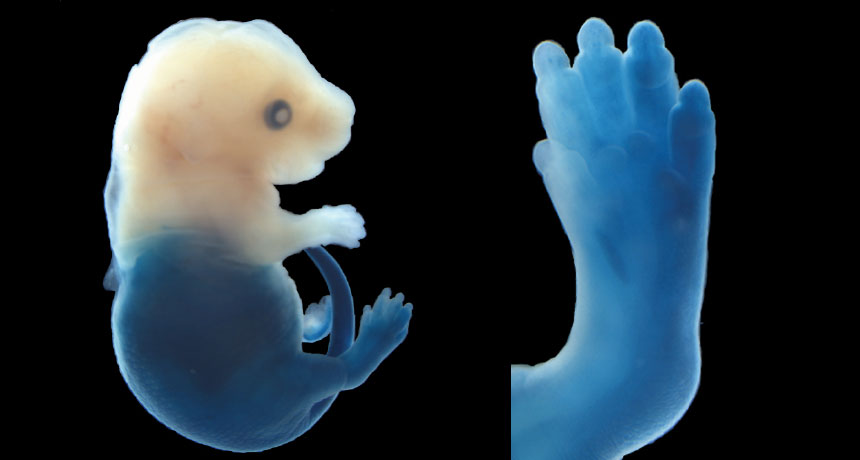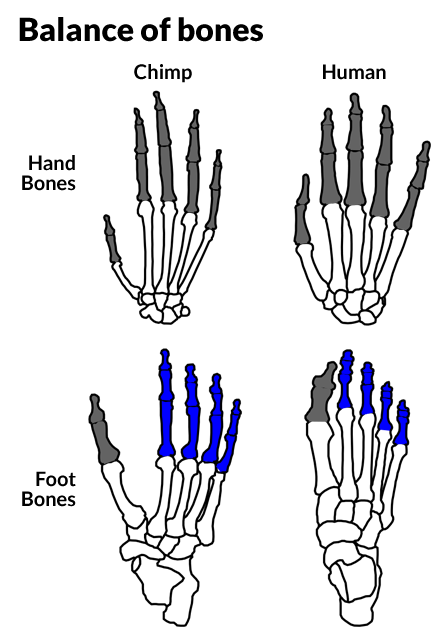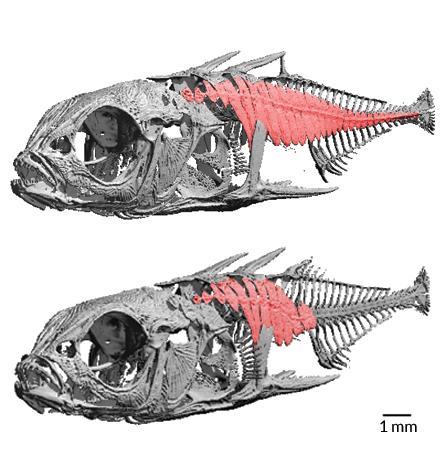
TRUE BLUE The blue coloring in this mouse embryo shows that a genetic switch that controls production of a bone- and tissue-building protein turns on genes in the lower half of the embryo’s body.
V.B. Indjeian et al/Cell 2016
- More than 2 years ago
Small tweaks of one gene may have helped humans to walk upright.
Losing a genetic switch that increases production of a protein called GDF6 may have created the big toe and helped shape the human foot for bipedalism, scientists propose in a paper published online January 7 in Cell. “This change is one that makes all humans different from other animals,” says developmental geneticist David Kingsley, a Howard Hughes Medical Institute investigator at Stanford University.
The gene GDF6 makes a protein that helps control bone growth. Researchers had already established that the protein is important for proper skeletal development. It is one of a large group of proteins that sculpt the skeleton and control growth of other body tissues. GDF6 may also be responsible for some evolutionary changes in other mammals and fish, Kingsley and colleagues say.

Kingsley’s group investigated what causes stickleback fish that live in salt water to have heavy armor plates made of bone while freshwater sticklebacks are lightly armored with smaller and fewer bony plates. The team tracked the genetic variant responsible for the armoring to a regulatory switch near GDF6. Freshwater fish have a version of the switch that increases GDF6 activity, blocking formation of some types of bone and therefore shrinking the armor plating, the team found. The finding indicates that altering levels of GDF6 can produce skeletal traits that may have evolutionary consequences. The researchers wanted to know if changes in the gene’s regulation shaped other organisms’ skeletons too.
In a previous study, Kingsley and colleagues found that humans are missing more than 500 different regulatory switches compared with chimpanzees and other mammals (SN: 4/9/11, p. 15). Among those 500 deleted bits of DNA are two near GDF6. Such regulatory switches are called enhancers.
Kingsley’s group studied the chimpanzee version of the enhancer in mice genetically engineered to carry it. The chimp enhancer was hooked to a gene that would indicate with a color change where in the body the switch turns on GDF6. The researchers found that the enhancer switches on GDF6 in the hind limbs, but not in the front limbs or head. In particular, the gene was switched on in the toes and in the muscle that controls the first toe (the big toe in humans, but a small toe in mice).
Mice engineered to lack GDF6 in their whole bodies had shorter second through fifth toes than mice that make normal levels of the protein, the researchers found.

Losing the enhancer may have caused humans to make less of the protein in the lower limbs, leading to shorter second through fifth toes. As a result, the big toe would have become more prominent and the human foot a more stable base for walking upright, Kingsley speculates.
The missing enhancer may not be the only thing that shaped the big toe, says Douglas Mortlock, a developmental geneticist at Vanderbilt University in Nashville. “It’s the one for which there’s the best evidence at this time,” he says. “It’s not definitive, but it is intriguing.” The researchers have not demonstrated that the missing enhancer affects GDF6 activity in humans, Mortlock adds. Many changes distinguish human feet from those of chimps — the big toe is straighter and not prehensile in humans, for instance — and those changes may be the product of tweaks to many genes.






